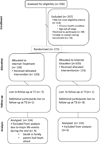Internet-delivered cognitive-behavioral treatment for adolescents with chronic pain and their parents: a randomized controlled multicenter trial
- PMID: 26335910
- PMCID: PMC4852469
- DOI: 10.1097/j.pain.0000000000000348
Internet-delivered cognitive-behavioral treatment for adolescents with chronic pain and their parents: a randomized controlled multicenter trial
Abstract
Internet-delivered interventions are emerging as a strategy to address barriers to care for individuals with chronic pain. This is the first large multicenter randomized controlled trial of Internet-delivered cognitive-behavioral therapy (CBT) for pediatric chronic pain. Participants included were 273 adolescents (205 females and 68 males), aged 11 to 17 years with mixed chronic pain conditions and their parents, who were randomly assigned in a parallel-group design to Internet-delivered CBT (n = 138) or Internet-delivered Education (n = 135). Assessments were completed before treatment, immediately after treatment, and at 6-month follow-up. All data collection and procedures took place online. The primary analysis used linear growth models. Results demonstrated significantly greater reduction on the primary outcome of activity limitations from baseline to 6-month follow-up for Internet CBT compared with Internet education (b = -1.13, P = 0.03). On secondary outcomes, significant beneficial effects of Internet CBT were found on sleep quality (b = 0.14, P = 0.04), on reducing parent miscarried helping (b = -2.66, P = 0.007) and protective behaviors (b = -0.19, P = 0.001), and on treatment satisfaction (P values < 0.05). On exploratory outcomes, benefits of Internet CBT were found for parent-perceived impact (ie, reductions in depression, anxiety, self-blame about their adolescent's pain, and improvement in parent behavioral responses to pain). In conclusion, our Internet-delivered CBT intervention produced a number of beneficial effects on adolescent and parent outcomes, and could ultimately lead to wide dissemination of evidence-based psychological pain treatment for youth and their families.
Conflict of interest statement
Conflict of interest statement
None of the authors have any conflicts of interest.
Figures
References
-
- Bender JL, Radhakrishnan A, Diorio C, Englesakis M, Jadad AR. Canpain be managed through the Internet? A systematic review of randomized controlled trials. PAIN. 2011;152:1740–1750. - PubMed
-
- Claar RL, Guite JW, Kaczynski KJ, Logan DE. Factor structure of the adult responses to children’s symptoms: validation in children and adolescents with diverse chronic pain conditions. Clin J Pain. 2010;26:410–417. - PubMed
-
- Cohen J. Statistical power analysis for the behavioral sciences. Hillsdale, NJ: Lawrence Erlbaum Associates; 1988.
Publication types
MeSH terms
Grants and funding
LinkOut - more resources
Full Text Sources
Other Literature Sources
Medical
Research Materials




